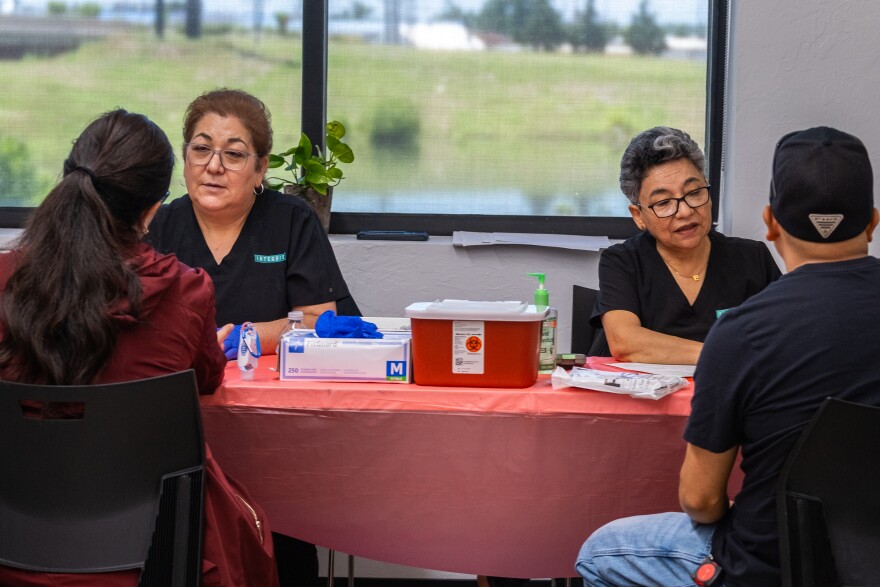A small crowd mills around a mini health fair at the Mexican Consulate in Oklahoma City. Most are there getting a passport, updating their Mexican voter cards, or tapping into some other service the consulate offers. The health fair is an intentionally centralized bonus.
Benjamin Canizales is a health promoter with the Latino Community Development Agency, or LCDA, and helps manage the fair every first and third Friday of the month, along with other community partners.
"We're doing free health screenings in regards to height, weight, BMI, blood, blood pressure, cholesterol and glucose," Canizales said.

He said these numbers are important to collect because they equip individuals with personal health insights and service providers with a look into the overall community's general well-being.
But what matters more, he said, is knowing what those numbers mean and what next steps people should follow once they learn them.
The latest state and federal data — published between 2020 and 2022 — shows Hispanic Oklahomans have the lowest reported prevalence of diabetes when compared to other ethnic and racial demographics, but have disproportionately high mortality rates compared to their population size.
Many are born with the condition, which is known as Type 1 diabetes. However, it can also be developed through excessive sugar consumption or Type 2 diabetes.
Either way, Latinos with diabetes die faster and more often than their fellow Oklahomans.
Canizales says the poor outcomes among Latinos can be attributed to a few consistent factors.
"A lot of times there's the barrier of just the language, and they're not going to know who to ask," he said.
Also, an issue, especially for low-income families and the elderly, is making time for their health at all.
"There's that, you know, if I go home, and I go to work and that's all I do, it's going to be really hard as well for me to figure out what health community resources exist," he said.

'Too many empanadas…' or an error? Why awareness matters
Dr. Carmen Romo runs the Integris Health Hispanic Initiative. She was pricking fingers to get visitors' blood-sugar levels. She said the reality on the ground shows prevalence among Latinos is likely much higher than available data suggests, as is the rate of poor outcomes.
"The worst of it is, for example, just within this room," Romo said, pointing to people at the health fair. "Probably 60% of the people here are either diabetic or pre-diabetic, and they don't even know. That's the worst part."
That means state and federal data are a bit problematic. They show numbers that are self-reported by people who've 'been to a doctor who's told them they're diabetic,' which makes it impossible for those who aren't aware to report accurately.
Maria De Jesus helps run the fair on behalf of the Mexican Consulate's Health Window. As she finished up a blood-sugar test with Romo's assistant, Leti, her numbers returned dangerously high.
Dr. Romo joked about it lightheartedly from afar, at first, caught up in the interview for this story.
"Too many empanadas," she said.
Until Leti showed her the paper with De Jesus' results.
"Well, look!" Leti exclaimed in Spanish, handing the sheet to the doctor.
"Now that's concerning," Romo said.
"Below 200 is normal," Leti said, as if to remind herself of what she knows is true. "No. You're scaring me," She said, turning to De Jesus, who sat quietly waiting for a band-aid and worried about the conversation happening over her head.
"Over 400," Romo finally said.
Anything over 200 milligrams per deciliter (mg/dl) is considered dangerous for people who aren't known diabetics and well-adjusted. More than one test showing 400 mg/dl requires immediate medical attention for high blood sugar.
De Jesus was showing levels around 600 mg/dl. She shouldn't have been walking around.
Errors can happen, so they tested her again later, after she had a bottle of water and walked around. Her numbers were back to what she expected: prediabetic levels without having fasted.
De Jesus says she was surprised to have such high numbers, even though she had been coasting under the 200 milligrams per deciliter range.
"Dare I say we have bad habits when it comes to regular checkups and exams," De Jesus said shortly after her second test. "To overcome that, we need to be more consistent in periodically reviewing our health."
Of the 31 people who stopped by the health clinic that day, 24 showed signs of being diabetic or prediabetic. That's more than 75 percent.
Dr. Romo says it comes down to education.
"When it comes to diabetes, our Hispanic people aren't very prepared," she said. "They tend to think that changing one recipe will cure them, and when it doesn't, they jump around doctors in hopes of finding the one magician who'll blow their illness away."
The end goal, Romo said, is to break the cycle of apathy in Latinos that's created by an ignorance of the stakes of chronic illness.
"Because if your grandma, your uncle, is diabetic, my intention is to give you the tools so that you won't be," she said.
There is no 'cure' for diabetes, Romo said, only management.
That management can be as benign as keeping a decent diet, regular exercise routine and an insulin pen around, Romo said, but when left unchecked, diabetes can lead to heart disease, amputations, blindness and death.
But, she says, hosting health fairs and awareness campaigns is only effective if people are willing to learn — and then act on their own behalf.







